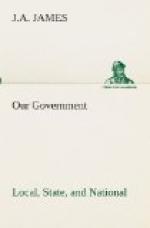[Footnote 1: The list here given is not complete, and the official titles are not the same in all States.]
SUPPLEMENTARY QUESTIONS.
Make a study of your local (town, village, or city) government.
1. Group the officers as legislative, executive, and judicial, respectively.
2. How many different methods are used in paying these officers?
3. Do all the voters ever assemble to make laws? If not, how is the will of the majority expressed?
4. What are some of the local regulations regarding the poor?[2] public health? protection from fire?
[Footnote 2: For a general account under this topic, see James and Sanford, “Government in State and Nation,” Chapter VIII. Health regulations are discussed in the same work, pp. 70-72.]
5. Who pays for the education that young people receive in the public schools?
6. How much has your local government done toward furnishing things that are not merely conveniences? How do you justify expenditures for these purposes?
7. Does the management of local government excite as much interest among the citizens as it should?
8. In what ways are students directly interested in having efficient local governments?
CHAPTER II.
COUNTY GOVERNMENT.
Why There Are Counties.—If the local organizations discussed in Chapter I could attend to all the interests that citizens have in common, then government would be a much simpler matter than it is. But just as almost every citizen has business and social relations outside of the neighborhood in which he lives, so different communities must have political relations with each other if they are to live in harmony. (For this and other reasons, which we shall learn presently, county governments are established. Their organization and functions correspond quite closely to those of the towns, villages, and smaller cities.)
Important County Officers.—The local governments cannot undertake alone the preservation of order or the protection of citizens against criminals. We have, consequently, an important officer, the sheriff, who with his deputies has power to make arrests. There is also the judicial side of county governments, seen in the court, with its judge. In this court another county officer, called the district or State’s attorney, prosecutes persons who are accused of crime; i.e., he finds evidence of the prisoner’s guilt and causes this evidence to be given by witnesses at the trial.
Functions of County Government.—Public highways are also matters of more than local interest. When an expensive bridge is to be built, or an important road in which several communities are interested is to be constructed, the county government can best raise the money and manage the work. So, too, in caring for the poor, the county may aid the local governments, or it may take entire charge of the paupers, and maintain a poorhouse.




